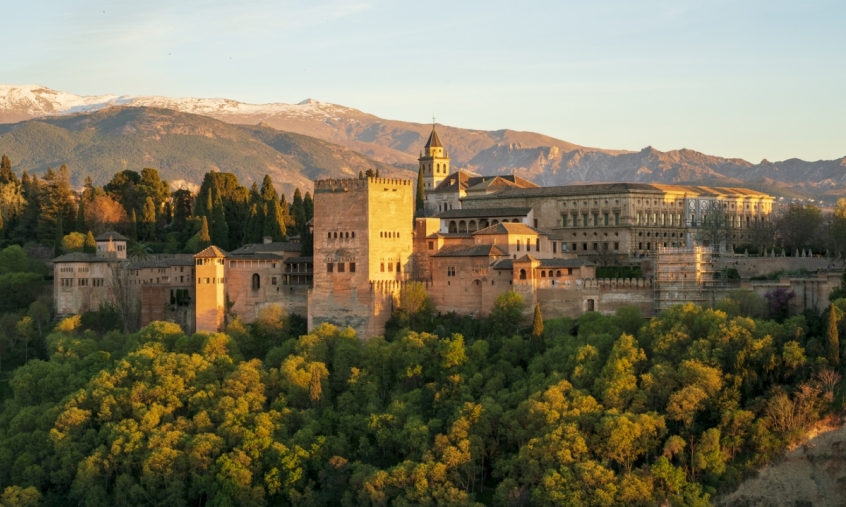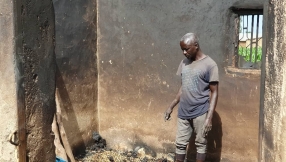
The writer of the Letter to the Hebrews reminds Christians that they are surrounded by a great "cloud of witnesses." (NRSV) That "cloud" has continued to grow in size since then. In this monthly column we will be thinking about some of the people and events, over the past 2,000 years, that have helped make up this "cloud." People and events that have helped build the community of the Christian church as it exists today.
In January 1492 – the same year that Columbus was landing in the New World – a momentous event was happening in the Old World. In that year the last Muslim ruler in Spain was defeated and the city of Granada was taken by the joint monarchs Isabella I of Castile and Ferdinand II of Aragon. Their marriage and joint-rule led, effectively, to the unification of Spain (as a union of two crowns). And this was accompanied by the eclipse of remaining Islamic power, which by this time was solely centred on Granada.
When its Islamic ruler, Emir Muhammad XII (also known as Boabdil) surrendered the city of Granada, with its spectacular palace and fortress of the Alhambra, he is reported to have said, "These are the keys to paradise." It was a testimony to the beauty of the palace, the grandeur of the city, and the wealth of the emirate that he was surrendering. As he left the city, he wept at the loss he was experiencing. Seeing his tears, his mother sharply remarked that he "wept like a woman," for what he "could not defend like a man."
With his departure, almost eight centuries of Islamic rule ended on the Iberian Peninsula. Muslim al-Andalus (remembered today in the name of the Andalusian region of Spain) was no more.
The creation of al-Andalus
During the eighth century, Muslim forces (based in North Africa) crossed the Straits of Gibraltar and captured large areas of land in what is today Spain and Portugal. The area conquered became known as al-Andalus.
Many (perhaps a majority) in the Iberian population under Muslim rule converted to Islam. Political, social, and economic advantages accompanied joining the now dominant group, and these converts became known as the musalimah, and their descendants, the muwallads. In the new social hierarchy, Christians, and Jews – who maintained their religious independence – occupied the lowest rung on the ladder of free people. Below them were slaves.
No medieval state practised human rights in a way that accords with modern standards and expectations. Nevertheless, it is fair to say that for large periods while Islam was the ruling power in al-Andalus, there was usually relative tolerance shown towards non-Islamic communities of Christians and Jews. Indeed, Jews experienced greater freedom under Islamic rule than they had under the previous Christian Visigothic rulers. However, things could be more complex and there were periods (particularly in the twelfth, and then fifteenth, centuries) when Christians and Jews were compelled to either convert to Islam or emigrate.
The 'Reconquista'
Muslim expansion beyond the mountains of the Pyrenees continued until 732. It was then that the Franks (of what is today France) under Charles Martel defeated a Muslim army at the Battle of Tours (on the river Loire). This battle marked the furthest advance of Islamic armies into France and was the beginning of a gradual Muslim retreat which would occur over the following centuries.
What Spanish describe as the 'Reconquista' (Reconquest) was a hugely complex period in which Christian and Muslim communities variously conflicted and cooperated in different combinations. It was made even more complex by competing groups and dynasties within both the Muslim and Christian communities. In time, though, the surviving Christian kingdoms of northern Spain (primarily Aragon and Castile) extended their authority southwards.
After 1250, the reconquest of Jaén, Córdoba, Seville, and Murcia, by the Castilians, and of Valencia and the Balearic Islands by the Catalan-Aragonese crown, meant that basically no independent Islamic state remained in Spain, except for Granada and Minorca (the latter until 1287). That in Granada lasted for a further 250 years, but was under increasing pressure from the Christian rulers. To survive, the emirs of Granada variously allied themselves with Islamic North Africa and the Christian Spanish kingdoms.
In the fifteenth century the Reconquista reached its climax. As it did so, intolerance increased on both sides in the conflict. Within Spain, this accelerated the process of Christian reconquest in order to save fellow Christians from oppressive actions. It was this which led to the "Granada War" (1482–92) and the completion of the Reconquista. Taking advantage of the civil war among competing Muslim factions, the Christians seized Ronda, Marbella, Loja, and Málaga, and laid siege to Granada itself. The Christian campaign was aided by Pope Sixtus IV granting tithe revenues to the Christian rulers and with a crusade tax. This assisted in the financial prosecution of the war.
The official surrender of Granada – and the end of Muslim political power on the Iberian Peninsula – occurred on January 2, 1492.
The rule of the "Catholic Monarchs"
Pope Alexander VI (pope 1492–1503) granted the title of "Católicos" (Catholics) to Isabella and Ferdinand, for their Christian piety and their dedication to the Catholic cause. It was a cause which bore down heavily on the non-Christian communities of al-Andalus. Shortly after the fall of the emirate of Granada, the victorious joint-monarchs imposed the Alhambra Decree on their newly conquered territory. According to it, Jews were expelled from Spain. Later policies also forced Muslims to convert to Christianity.
There were signposts to these later events in policies that had developed even before the finally victory over Granada. The "Catholic Monarchs" were militant and energetic in their desire to enforce official Catholic beliefs across their kingdoms. It should be remembered that this was the last generation of Western Catholic Christendom and – while there were critics of the status quo – there was, as yet, no Catholic/Protestant schism which would shatter the unity of the Western Church from 1517 onwards. Nevertheless, there were already those within the Western Christian community who criticised aspects of the Church and were met by a push-back (often using lethal force) by those in power who were determined to defend Catholic beliefs. In the Iberian Peninsula this enforcement of official Catholic Christian orthodoxy had an additional prompt from the presence of large non-Christian communities. These soon came to feel the force of royal and ecclesiastical sanctions.
As early as 1478, Pope Sixtus IV had issued a bull (papal decree) which established a Holy Office of the Inquisition in Castile. It aimed to ensure that any Jews and Muslims who converted to Christianity did not revert to their earlier beliefs. It was not enough that they had converted. The anxiety among those in power was that such conversions masked covert continuance of old beliefs. This meant that members of these communities remained under suspicion as "alien others" even after they had adopted Christianity.
With the fall of the emirate of Granada in 1492 the drive to enforce religious uniformity across all the Spanish lands accelerated. This led to the expulsion of all Jews who refused to convert to Christianity. In 1492 the Alhambra Decree, gave Spanish Jews just four months to either convert to Catholicism or leave Spain. Many thousands of Jews left. Most emigrated to one of Portugal, North Africa, the Low Countries, Italy, or the Ottoman Empire.
This brutally ended previous interaction between the two communities. In Spain (prior to their expulsion in 1492) the writings of scholars such as the Portuguese Jewish philosopher, Bible-commentator, statesman and financier Don Isaac Abarbanel (1437–1508), who was a well-known theorist regarding Jewish messianic ideas, reveal an active interaction between Jewish and Christian beliefs. He was a prominent financial court adviser, firstly in Portugal and then in Spain, and was not unique in such influence. But those days were now over.
These traumatic events had a huge impact on western Judaism. The turbulence of the late fifteenth and early sixteenth centuries convinced many that the apocalypse was at hand. What occurred to the Jewish inhabitants of the Iberian Peninsula in that period was seared on Jewish consciousness. This was the end of a settlement there that stretched back centuries. Following the shock of their expulsion from Spain, in 1492, many Jews were more than ever occupied with messianic hopes and eschatology. In such an atmosphere, many turned to kabbalistic (esoteric mystical) studies. It was a movement born of despair.
However, for those who converted and remained in Spain, the trauma was not over. Many who had converted – known as conversos if they had converted from Judaism, and mudejars (later known as moriscos) if they had converted from Islam – were accused of secretly practising their original religion. This was regarded as "crypto-Judaism" and "crypto-Islam." Many of theJewish conversos were members of communities in which conversions had occurred as early as the late fourteenth century. Despite being officially Christian for several generations, they remained under suspicion. This suspicion led to mounting sanctions against then from 1480 onwards; and this increased with the inclusion of more Jews and Muslims within Catholic rule after 1492. In this febrile atmosphere of suspicion, many conversos and moriscos were imprisoned, interrogated, tortured, and in some cases burned. The last trial for "crypto-Judaism" in Spain was held as late as 1818.
Among Muslims, the new intolerant policy reversed previous understandings. Until 1492 Muslims living in parts of Spain reconquered by Christians were usually guaranteed freedom of religion by treaty arrangements. After the fall of Granada this tolerance ended. Islamic theological texts were destroyed and pressure to convert mounted. This led to rebellions, which (in turn) ratcheted up repression. In 1502, the remaining Muslims in Granada were offered the choice of baptism or exile. Many – who knew no other home but Spain – accepted baptism but continued to practise Islam secretly. In 1526 the Muslims of Valencia and of Aragon were also forced to convert. After 1526, Islam was officially prohibited in Spain. However, the converted moriscos continued to speak and dress like Muslims. Many practised Islam under cover. They were regarded by many Catholics as the "enemy within," and allies to Islamic states abroad in conflict with Spain.
In 1566, Philip II issued a law which forbade the Granada moriscos from using their traditional language, customs, and dress. In response they revolted in 1569. This led to two years of war, which culminated in them being deported to northern Spain. However, they continued to be restless and did not assimilate. Eventually, in 1609, their deportation from Spain was ordered. Within five years, about 300,000 moriscos were driven out. Most went to Algeria, Tunisia, and Morocco.
The religious complexity of medieval Spain was ended with repression and expulsion.
Martyn Whittock is a historian and a Licensed Lay Minister in the Church of England. The author, or co-author, of fifty-six books, his work covers a wide range of historical and theological themes. In addition, as a commentator and columnist, he has written for several print and online news platforms and been interviewed on TV and radio news and discussion programmes exploring the interaction of faith and politics.
His recent books include: Daughters of Eve (2021), Jesus the Unauthorized Biography (2021), The End Times, Again? (2021), The Story of the Cross (2021), and Apocalyptic Politics (2022). The last title includes exploration of the impact on apocalyptic beliefs, within the Jewish community, of the expulsion from Spain. His latest book, American Vikings: How the Norse Sailed into the Lands and Imaginations of America (2023), explores evidence for Norse exploration of North America and its impact on culture and politics there.













